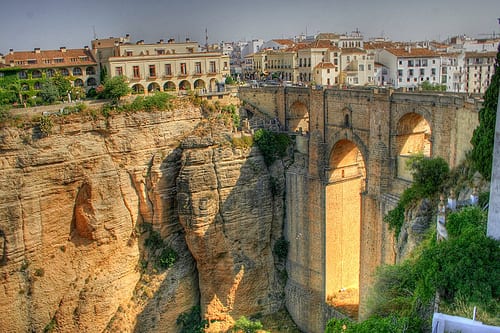SITTING on a plateau of large, rugged cliffs Ronda was unsurprisingly one of the last Moorish cities to fall during the Reconquest of Spain by the Catholic monarchs.
It is easy to see why it was so hard to seize during a two-hour walking tour around its old town.
Start your walk at the top of the Tajo gorge, which is topped with ancient houses teetering on the cliff top.
Cross the famous Puente Nuevo (New Bridge), and head right, through the winding alleys, keeping close to the gorge. Be warned, though, looking over the walls at that 100 metre drop is not for the faint hearted!
At Plaza Duquesa de Parcent you’ll come across the Santa Maria la Mayor church. Construction began in 1485 but was not completed until the 17th Century, which explains its combination of different artistic styles.
The three naves include Gothic columns, which survived an earthquake in 1580 that destroyed part of the church. The image of the Virgin, one of the building’s most important elements, is attributed to the work of Montañes or La Roldana, depending on which researcher you choose to favour.
Across the road you will find the stunning neoclassical town hall, with its stunning Ronda stone arches.
Head down to Plaza San Francisco and the charming Almocobar gate, a former Arabic gate and well-fortified entrance to the town.
From here, double back before heading into the eastern part of the old town looking out for the fabulous Mina, where the town’s Arabic defenders could find water in a time of siege.
Further down the hill lie the Arabic baths, which are considered one of the best preserved in Europe and were still in use in the 17th Century.
According to the Muslim custom of the time, those coming into the city needed to be purified, explaining their location next to the ancient Puente Arabe.
From here, head uphill alongside the north of the gorge until you arrive in the new town of Ronda.
You will finally make it back to the famous bridge, where just 200 metres away is the town’s must-see Plaza de Toros, the oldest bullring in Spain and where the rules of bullfighting were also codified over 300 years ago.
Two famous bullfighting families have emerged from the ring; the Romeros being the first. Pedro Romero was the most notable of the Romeros, he killed more than 5000 bulls, without suffering injury to himself, during the course of his career.
A second dynasty of bullfighters emerged in the 20th century, the Ordonez family. Father and son Cayetano and Antonio Ordonez have been credited with luring both Ernest Hemingway and Orson Welles into the crowds of spectators, thanks to their seductive bullfighting technique.
Antonio went on to found the famous Goyesca bullfight, now one of the most expensive, and well-attended, fights in the country. It takes place every September, and both spectators and fighters dress in traditional clothing and the town is decked out in decor reminiscent of the period.
The bullfighting museum within the ring has sections dedicated to these two families, among other memorabilia which gives a good insight into one of Spain’s bloodiest traditions.
Click here to read more News from The Olive Press.








